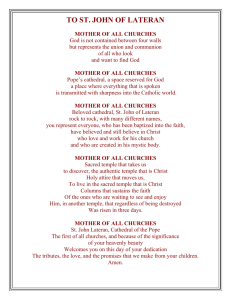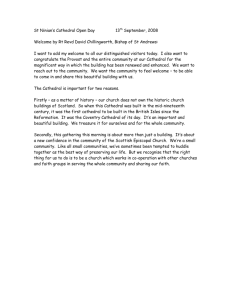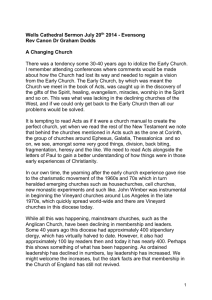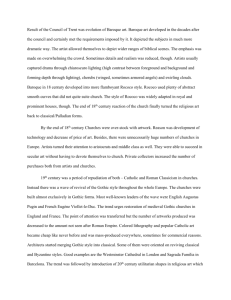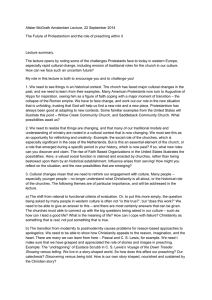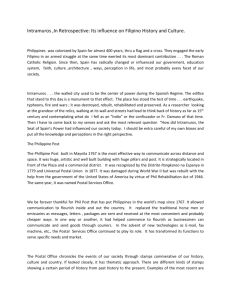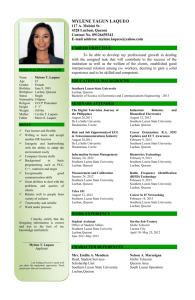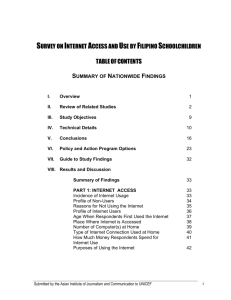Beautiful Churches
advertisement
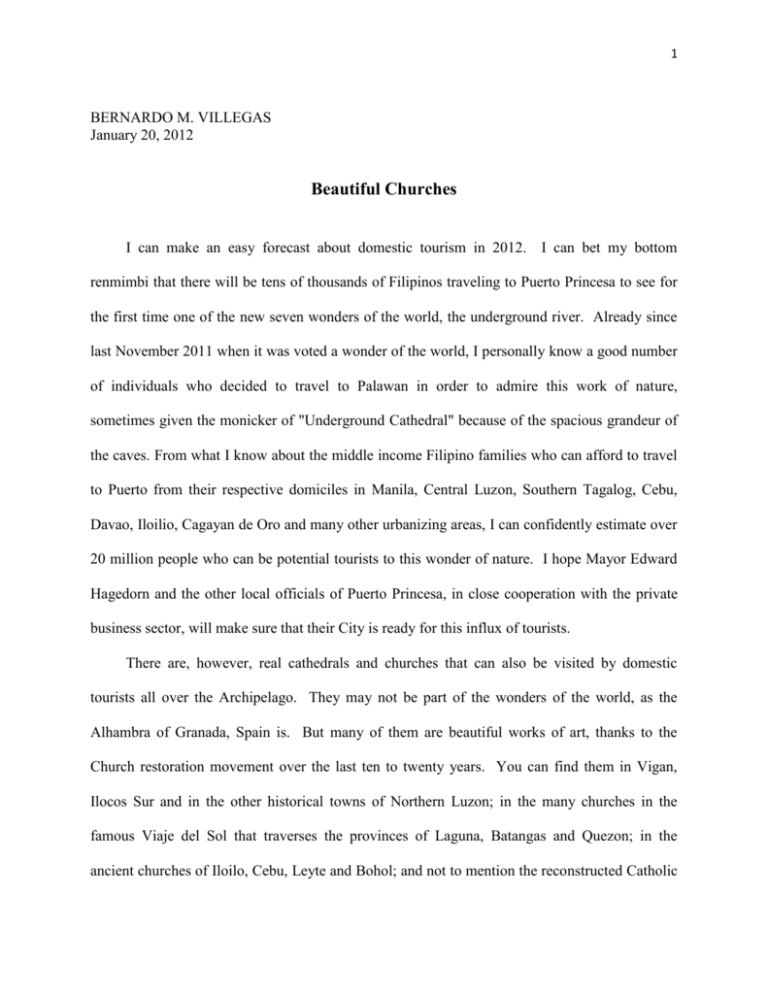
1 BERNARDO M. VILLEGAS January 20, 2012 Beautiful Churches I can make an easy forecast about domestic tourism in 2012. I can bet my bottom renmimbi that there will be tens of thousands of Filipinos traveling to Puerto Princesa to see for the first time one of the new seven wonders of the world, the underground river. Already since last November 2011 when it was voted a wonder of the world, I personally know a good number of individuals who decided to travel to Palawan in order to admire this work of nature, sometimes given the monicker of "Underground Cathedral" because of the spacious grandeur of the caves. From what I know about the middle income Filipino families who can afford to travel to Puerto from their respective domiciles in Manila, Central Luzon, Southern Tagalog, Cebu, Davao, Iloilio, Cagayan de Oro and many other urbanizing areas, I can confidently estimate over 20 million people who can be potential tourists to this wonder of nature. I hope Mayor Edward Hagedorn and the other local officials of Puerto Princesa, in close cooperation with the private business sector, will make sure that their City is ready for this influx of tourists. There are, however, real cathedrals and churches that can also be visited by domestic tourists all over the Archipelago. They may not be part of the wonders of the world, as the Alhambra of Granada, Spain is. But many of them are beautiful works of art, thanks to the Church restoration movement over the last ten to twenty years. You can find them in Vigan, Ilocos Sur and in the other historical towns of Northern Luzon; in the many churches in the famous Viaje del Sol that traverses the provinces of Laguna, Batangas and Quezon; in the ancient churches of Iloilo, Cebu, Leyte and Bohol; and not to mention the reconstructed Catholic 2 churches in Metro Manila, starting with the Manila Cathedral, the Immaculate Conception Cathedral in Cubao, the Sto. Domingo Church in Quezon City and the more modern St. James the Apostle church in Ayala Alabang, among others. Visiting these works of art can combine tourism with the act of worship and adoration for Filipino Catholics, especially the families of overseas Filipino workers when they come for their regular visits home. These Filipinos can be inspired by the words of Pope Benedict XVI in an address he gave during a general audience in Rome last August 31, 2011. He spoke about how beauty can lead us to God: "Today, I would like to consider briefly one of these channels that can lead us to God and also be helpful in our encounter with Him: It is the way of artistic expression, part of that 'via pulchritudinis'--'way of beauty'--which I have spoken about on many occasions, and which modern man should recover in its most profound meaning. "Perhaps it has happened to you at one time or another--before a sculpture, a painting, a few verses of poetry or a piece of music--to have experienced deep emotion, a sense of joy, to have perceived clearly, that is that before you there stood not only matter--a piece of marble or bronze, a painted canvas, an ensemble of letters or a combination of sounds--but something far greater, something that 'speaks,' something capable of touching the heart, of communicating a message, of elevating the soul." What is true for a sculpture, a painting, a concerto, or verses of poetry can be applied with greater force to a beautiful cathedral or church. As Pope Benedict XVI said: "But there are artistic expressions that are true roads to God, the supreme Beauty--indeed, they are a help to us in growing in our relationship with Him in prayer. We are referring to works of art that are born of faith and that express the faith. We see an example of this whenever we visit a Gothic cathedral: We are ravished by the vertical line that reach heavenward and draw our gaze and our 3 spirit upward, while at the same time, we feel small and yet yearn to be filled....Or when we enter a Romanesque church: We are invited quite naturally to recollection and prayer. We perceive that hidden within these splendid edifices is the faith of generations." In most of the old churches in the Philippines that have been restored, it is the baroque art that predominates. I encourage families who plan their own itinerary in domestic tourism or the travel agents who help them in their desire to know better their own country to include as one of their objectives in planning the tour the spiritual dimension of domestic travel. Let us respond to the appeal of the Pope: "Dear friends, I invite you to rediscover the importance of this way for prayer, for our living relationship with God. Cities and countries throughout the world house treasures of art that express the faith and call us to a relationship with God. Therefore, may our visit to places of art be not only an occasion for cultural enrichment--also this--but may they become, above all, a moment of grace that moves us to strengthen our bond and our conversation with the Lord..." May the New Year 2012, which will be a difficult time for most economies in the developed world, be an opportunity for Filipino families to discover the beauty of their own country, not only helping the national economy grow through their expenditures on domestic tourism but also deepening their Catholic faith as they visit the works of art contained in many of our Churches. For comments, my email address is bernardo.villegas@uap.asia.


